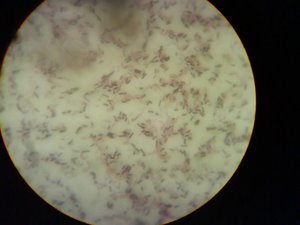Week 11
Today's Topics:
○ Biotechnology
Announcements:
○ Exam: 16/1/07
Lecture Topic:
○ What is it? The use of microorganisms, usually on a large scale, to produce valuable products (eg beer, cheese, antibiotics)
○ These are usually enhancements of natural reactions, amplified for better yield.
○ Genetic manipulation now permits production of products that microorganisms do not naturally produce.
○ Main organisms used:
§ Fungi (yeasts & moulds)
§ Streptomyces spp.
§ Escherichia coli
§ Bacillus subtilis
○ Microorganisms are often altered by mutation or recombination, to achieve high metabolic specialisation.
○ Requirements:
§ Must be able to grow on large scale
§ Should grow rapidly, and yield product in a short time
§ Must be able to grow on cheap culture, ideally waste from another process.
§ Should be amenable to GM.
§ Must not be pathogenic
○ Examples:
§ Antibiotics
§ Vitamins
§ Enzymes
§ Alcohol
§ Vinegar
§ Bioconversion
○ Primary Metabolites
§ Produced during growth of culture (eg ethanol)
§ Result of growth
○ Secondary Metabolites
§ Produced at end of growth - at, near, or in, stationary phase.
§ Survival mechanism (eg antibiotics, to kill off competing organisms, or enzymes to free up more food)
§ Not essential for growth & reproduction
§ Dependent on growth conditions (especially medium)
§ Often possible to get massive overproduction.
○ Vessels used are called fermentors, and often hold hundreds of thousands of litres.
○ Two classes: ærobic and anærobic.
○ Antibiotics:
§ Substance produced by microorganisms that kill or inhibit others.
§ Most useful antibiotics produced by filamentous fungi and by Actinomycete group (eg Streptomyces spp.)
○ Penicillin
§ Original: Penicillium notatum - low yield (1-10μgcm-3)
§ 1943: Penicillium chrysogenum, further improved
§ Now Penicillium chrysogenum, in aerobic stirred fermentors (50,000μgcm-3)
○ β-lactam antibiotics: Penicillin & its relatives.
§ Biosynthetic penicillins: result of biosynthesis
§ Semisynthetic penicillins: chemically modified
§ Interfere with cell wall production.
○ Vitamins & amino acids
§ Most made by chemical synthesis
§ A few are too complex for this, eg B12 (Propionibacterium spp. & Pseudomonas spp.), and riboflavin (Ashbya gossypii)
§ Amino acids are regulated by inhibitory feedback - mutant species resist this inhibition, and thus overproduce. (Eg use of S-aminoethylcysteine to produce resistant species, where lysine will not inhibit production by aspartokinase).
○ Extracellular enzymes (excreted into medium)
§ Capable of digesting e.g. cellulose & starch
§ Useful in food, pharmaceutical & textile industries
§ Proteases and lipases from alkaliphilic Bacillus lichenformis used in detergents (e.g. biological washing powders)
§ Amylases and glucoamylases: production of glucose from starch.
○ Microbial bioconversion - biotransformation
§ Used for specific reactions beyond organic chemistry
§ E.g. Rhizopus nigricans converts progesterone to 11α-hydroxyprogesterone, which is then converted chemically to hydroxycortisone and then cortisone.
○ Genetically engineered microorganisms
§ E.g. use of E. coli to produce human growth hormone & insulin
§ Contain gene from another organism
§ Grow rapidly on simple media
§ Produce massive amounts of blood proteins, hormones, etc.
§ Main hosts: Escherichia coli, Bacillus subtilis, Saccharomyces cerevisiae.
§ Work from mRNA (to avoid introns), and use reverse transcriptase to make DNA, and then ligate this into a plasmid.
○ Vaccines
§ Killed or attenuated pathogens (or fractions) that produce immunity.
§ Body develops antibodies against surface proteins
§ Genetically engineered antigens
□ Cheaper
□ Easier to purify
□ Free from other proteins
§ E.g. Hepatitis B antigen cloned into S. cerevisiae
○ BT toxin
§ Ulcerates gut wall in larvae
§ Gene transferred to P. flourescens, which inhabits rhizosphere. Innoculation protects roots from pests.
§ Then transferred to plants
§ Constant exposure stimulated BT resistant pests.
○ Herbicide resistance:
§ E.g. gene for resistance to glyphosate transferred into plants, to allow glyphosate to be used to suppress pests without affecting crop.








